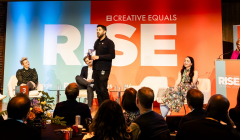
Are we leaving men and boys behind?
At Creative Equal’s RISE event, industry leaders consider how to reframe boys and men in marketing
Every March, masses attend South by Southwest (SXSW), the world’s leading tech and innovation conference in Austin, Texas. Over seventy thousand visitors come to go deeper into what is often described as the ‘Fourth Industrial Revolution’, the technological revolution.


Every March, masses attend South by Southwest (SXSW), the world’s leading tech and innovation conference in Austin, Texas. Over seventy thousand visitors come to go deeper into what is often described as the ‘Fourth Industrial Revolution’, the technological revolution, encompassing things like AI, the Internet of Things and autonomous vehicles. This was HeyHuman’s sixth rodeo in Austin.
Across thousands of talks, panels and keynote speeches, what we found was encouraging. A practical acceptance of the transformative potential of tech, but also a recognition that in order to fully embrace it we need to humanise it.
That’s what inspired our overarching theme from SXSW 2018: Feel the Future. To fully realise the cultural, societal and commercial value of the tech revolution, we must remember there is an irrational and feeling human being at the receiving end of it all.
Fresh of the plane, we summarised our thoughts in a top 5 themes and how we thought these insights can start to be applied now to brands and businesses.
Tim O’Reilly, leading tech speaker and author of ‘What’s the Future and Why It’s Up to Us’, spoke about the need to move beyond ‘bad maps’ that falsely suggest that technology risks making humanity redundant.
In Do More. Do Things That Were Previously Impossible, O’Reilly highlighted his belief that robots will help create rather than take jobs. He cited an Amazon example saying that by adding 45,000 robots, Amazon enabled 200,000 additional jobs.
The opportunity is think about how to reframe the tech opportunity as an augmentation of our current approaches. For businesses this will be about how they can really look at service design and optimise mobile opportunities as their primary access point with the majority of goods and services.
Hearing the latest research from Google and Facebook at SXSW, the biggest platforms could still do more to move the social media conversation forward, particularly focusing on issues such as fake news, brand safety and over-commercialisation of the newsfeed.
In this context, Raashi Rosenberger from Pinterest was great on how to better meet audience mind-sets in moment. In her session, The Flow State: How to Tap Into Consumers’ Brains’, Rosenberger highlighted the need to be more empathetic, to really create content people will respond to emotionally. She gave a great example where a paint brand used analysis of dominant colours in people’s Pinterest boards to proactively suggest new paint colours.
The opportunity is for brands to approach social as a genuine conversation. Brands that see higher levels of response need to strive not only to be interesting, but interested. Thinking about how to better use data, or a more localised approach to really dial up relevancy will pay back.
New University of Michigan neuroscience research revealed how to maximise communications effectiveness in a world where most online behaviour is done on auto-pilot. In Emoticulture: How Date & Science Create Happiness, Marcus Collins, SVP of Doner agency and Saleem Alhabash, Assistant Professor at Michigan State University took us through their use of neuroscience and data to better connect with people through ‘radical empathy’.
These insights build on HeyHuman’s own approach to be brain-friendly, so Collins was preaching to the converted. He focused on the relevancy and gave a great example from US sandwich shop Pot Belly. With a brand purpose of ‘making people happy’, Pot Belly used data to surprise and delight those expressing negative emotions on Twitter. Or if it rained they had weather triggered 'turn that frown upside down' spot sales. Their results were impressive for a small budget, with 10 x increase in brand interaction, 20 x more Twitter followers and a 1.4% increase in store footfall.
The opportunity for brands is to unpack neuroscience in communications practice to maximise fleeting interactions with ‘radical empathy’. Looking to create positive emotion where data suggests there is pain in customers’ lives will reap benefits.
We heard from AI experts including Megan Smith, Ex CTO to President Obama and Fei-Fei Lin, AI Professor at Stanford. Democratising AI for Individuals and Organsations highlighted AI as hugely transformative for commerce, society and culture. The main point was that everyone should start their AI journey today or risk missing out tomorrow.
The macro opportunity is to discover and engage with AI initiatives at a national level and consider how you can start to experiment with AI. This might simpy be how to best use chatbots or thinking about integration with Alexa style voice assistants.
This expression was one answer that grabbed us out of everything we heard at SXSW. Alexander Manowsky, Futurist at Daimler AG said it as part of the AI panel discussions, Humanizing Autonomy. It was a brilliant summation of the complex challenge of tech, spanning science, technology and culture.
It’s clear that to really embrace the future opportunity we need a more empathetic approach to communicate with each other and, in fast flowing channels like social media, it pays to be aware of context and how we are evoking, or reacting to people’s feelings.
Empathy between man and machine will define how we move forward, encompassing many different sectors. What we heard loud and clear at SXSW this year is that emotionally driven, unconscious decision-making will not only remain vital in the future, but will be the key that allows tech to really capture hearts and minds.
Neil launched HeyHuman in March 2014, taking a step back to think about the future for agencies and new ways of thinking and working. This started out with a belief in 'Human Brands' and an approach focused on behavioural economics and neuroscience. Previously Neil has led, launched and re-positioned agencies in the UK and in Europe, including being a Board member of Rainey Kelly Campbell Roalfe/Y&R, Strategic Planning Director of The Farm and Managing Partner of Rapp.
Looks like you need to create a Creativebrief account to perform this action.
Create account Sign inLooks like you need to create a Creativebrief account to perform this action.
Create account Sign in